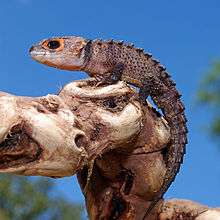Tribolonotus gracilis
| Red-eyed crocodile skink | |
|---|---|
 | |
| Scientific classification | |
| Kingdom: | Animalia |
| Phylum: | Chordata |
| Class: | Reptilia |
| Order: | Squamata |
| Family: | Scincidae |
| Genus: | Tribolonotus |
| Species: | T. gracilis |
| Binomial name | |
| Tribolonotus gracilis de Rooij, 1909[1] | |
Tribolonotus gracilis is a species of skink endemic to New Guinea.[1]
Habitat
Tribolonotus gracilis are found in New Guinea island in Indonesia and Papua New Guinea. They live in tropical forests and have also been found in human-populated areas.
Common names
They are commonly known as red-eyed crocodile skinks, or, rarely, red-eyed bush crocodile skinks.
Behavior
Tribolonotus gracilis is one of the few species of lizards that vocalize[1] when in distress. When startled, they tend to freeze and have been known to "play dead" (even when handled).
Reproduction
Red-eyed crocodile skinks can be sexed using the pores on their front feet, as only males have these "pores". Females have only a single working ovary (right ovary), laying one egg at a time. The female often curls around the egg. They show tendencies for mother-child family groups. Male crocodile skinks will battle other males for females and females can be territorial as well.
Captivity
Red-eyed crocodile skinks are popular in the pet trade but are still considered exotic pets. For captivity they require a large terrarium that can withstand high humidity that the species requires. For nutrient most red-eyed crocodile skinks eat a variety of insects such as fruit flies, mealworms, and small crickets. Like most species of reptiles in captivity, most reptiles need a calcium supplement with their regular food.[2]
References
- 1 2 3 The Reptile Database. www.reptile-database.org.
- ↑ Russell, Matt. "Crocodile Sking Animal Biography" (PDF). Animal Biography. Retrieved 26 January 2017.
Further reading
- de Rooij N. 1909. "Reptilien. (Eidechsen, Schildkröten und Krokodile)." Nova Guinea 5 (3): 375-383. ("Tribolonotus gracilis, n. sp.", pp. 381–382).
- "Red Eyed Crocodile Skink (Tribolonotus gracilis) Care Sheet | Reptile Blog". www.kjreptilesupplies.co.uk. Retrieved 2017-01-26.
External links
| Wikispecies has information related to: Tribolonotus gracilis |